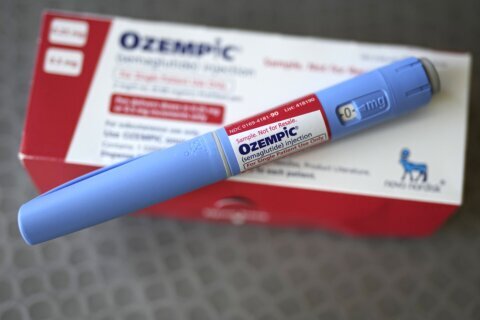Smart portioning
While you may think that what you eat is the key to good health, how much you eat is just as important. As a nutritionist, while I believe that all foods fit, practicing portion control is important for most of them.
Except for water, whole fruits and non-starchy vegetables — after all, no one gains weight from eating too many carrots or berries — to optimize health, maintain your weight or even lose a few pounds, paying attention to how much you put on your plate or in your bowl is key.
It’s so easy to eat too much because portions have grown considerably over the past 50 years and we are surrounded by oversized portions, which have become the norm. As I wrote in my book “Finally Full, Finally Slim,” many bagels and muffins are now equivalent to five bread slices, and a typical steak at a restaurant can weigh a pound and contain several days’ worth of protein.
For the good news, paying attention to how much food constitutes a healthy portion size, eating mindfully and tuning into your inner wisdom and hunger levels can help with weight loss. In my private practice, I have counseled hundreds of clients who often make common portion size mistakes. I share five of them here, along with simple ways to avoid them.
1. You pour enough granola to fill your cereal bowl.
Consider this scenario. You’re rushing to get ready for work or get the kids off to school or camp and you sit down to eat breakfast and you pour granola into your cereal bowl. When was the last time you measured it out or checked the Nutrition Facts food label before pouring it into your bowl?
Most of us pour too much of all cereal types into our breakfast bowls, but granola, in particular, tends to be high in calories, fat and sugar. Granola can easily contain more than 500 calories per cup. And it’s super easy to pour a cup or two of granola into your bowl without realizing.
The fix: Yes, you can eat granola, but I would suggest enjoying it as a topping on yogurt or adding it to your cereal flakes. Because it’s so calorie-dense, a healthy portion size is around ¼ cup, which fills about two shot glasses. I’d also suggest keeping measuring cups handy and using them every so often to get an idea as to what a serving really looks like.
If you’re ambitious, you may even want to make your own granola using rolled oats, a mild cooking oil, maple syrup, cinnamon, vanilla, dried fruits and your favorite nuts. Don’t expect it to be low in calories, but it will taste better, be free of preservatives and likely contain less added sugars than most store-bought varieties.
2. You enjoy nuts but eat too many.
You may have heard about the beneficial effects of eating heart-healthy fats like nuts. Nuts also contain fiber, protein and a variety of vitamins and minerals, including vitamin E and magnesium. However, you think they are good for you — which they are — so you eat too many. Unfortunately, because nuts are high in fat, the calories add up rather quickly. For example, I have seen clients who eat a cup of nuts at a sitting, which can easily contain 800 calories. A healthy portion is around an ounce or ¼-cup and 150 to 200 calories.
The fix: When possible, buy nuts with their shells. It takes longer to eat them, and you see the shells on your plate, which is a perfect reality check. In one study, subjects given in-shell pistachios ate 41% fewer calories compared to those given shelled pistachios. On occasion, measure out a ¼-cup serving. This translates into around 20 almonds or 50 pistachios.
While you don’t need to weigh and measure your food constantly — after all, who has time for that? — doing so a few times can educate you on just how many nuts you’re eating. A handy visual for the perfect nut portion is around a handful. And since it’s not an exact science, if you have a larger hand… then you can probably get away with eating a little more.
3. You stock up on large bags of snack foods like chips.
Buying bigger packages of snack foods are often a great bargain. Because ultra-processed foods like chips are cheap for the manufacturer to produce, it often costs you, the consumer, just a few cents more for a larger bag. While it’s a great idea to buy paper towels in bulk, I wouldn’t suggest it for food, especially junk food. Research shows that we eat more — often lots more! — from bigger packages, and we don’t feel any more full.
The fix: Leave the jumbo bags of snack foods on the shelf and purchase single-serving bags instead. Here’s another option if you have a large family and can benefit from the cost saving from buying the bigger sizes. When you first open the bag, portion out the contents into individual servings and store them in small baggies or containers. A snack food portion of chips is one ounce, which is around a cup. Another idea is to make your own air-popped popcorn which is a healthy whole-grain snack and you can enjoy a 3-cup portion, which is an ounce.
4. You add an entire avocado to your salad.
Just like nuts contain heart-healthy fats, so do avocados. This delicious green fruit is high in monounsaturated fats, fiber, and vitamins and minerals including vitamin C, potassium and vitamin E.
But as healthy as they are, their calorie content adds up quickly. A medium avocado contains around 250 calories. These days, people are adding avocado to everything from smoothies to brownies, while also spreading it on toast.
And yes, you can have too much of a good thing. Even though avocados are rich in healthy fat, they contain the same number of calories as fats that can clog your arteries, so practicing moderation is important. Adding an entire sliced avocado to your salad is a sure-fire way to overdo it, especially if you’re also adding dressing to your salad.
The fix: Include avocados in your food plan but eat a smaller portion. I’d suggest spreading it on whole grain toast or adding ¼ medium avocado to a salad. While avocados are technically a fruit, consider them a fat, and a little goes a long way. A small portion can help you to feel full. The fat and the fiber are super satisfying, tasty and a winning combination. Balance it with a variety of colorful vegetables and fruits.
5. You eat ice cream straight from the container.
Who doesn’t love ice cream, especially in the summer months? A common mistake that I’ve seen many people make is to take out a pint of ice cream from the freezer, grab a spoon and start eating. Pretty soon, they’ve finished the entire container. Eating straight from the container is one of the easiest ways to overeat.
The fix: Portion out a scoop of ice cream (around ½-cup), put it in a small bowl, sit down and enjoy it. Take the time to savor each bite. And using a teaspoon instead of a tablespoon may be helpful. And speaking of ice cream, pick the type you like best and enjoy the real thing by skipping the “diet” versions, which often don’t taste great. It’s far better to eat a smaller portion of a dessert you love than a larger portion of one you really don’t enjoy.
5 most common portion size mistakes people make:
— You pour enough granola to fill your cereal bowl.
— You eat too many nuts.
— You stock up on large bags of snack foods like chips.
— You add an entire avocado to your salad.
— You eat ice cream straight from the container.
More from U.S. News
11 Healthy Food Swaps to Lose Weight
8 Ways to Eat Healthy During the Summer
Most Common Portion Size Mistakes originally appeared on usnews.com







